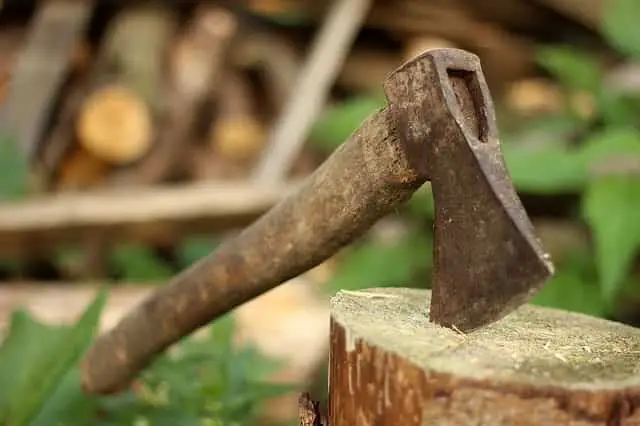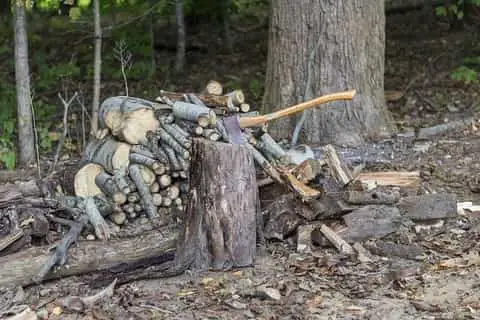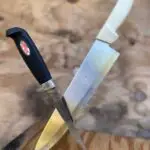The splitting axe is important to both occasional firewood cutters and regular woodmen. It’s a useful tool for when you need to break chunks of wood into smaller pieces. But how sharp should your splitting axe be?
A splitting axe should be sharp enough to avoid a bounce when it strikes harder wood pieces. It doesn’t have to be razor-sharp because it splits wood along the grain. However, some woodworkers prefer very sharp splitting axes. The key is to keep the axe sharp enough to ensure efficiency.
In this article, you’ll learn more about the importance of a sharp splitting axe, the level of sharpness you need to achieve, and how you can keep yours sharp for every job.

Table of Contents
- Why You Need To Sharpen a Splitting Axe
- How Sharp Should Your Splitting Axe Be?
- Advantages of Using a Splitting Axe
- How To Sharpen Your Splitting Axe
- Tips To Keep in Mind When Sharpening the Splitting Axe
Why You Need To Sharpen a Splitting Axe
All woodworkers understand the need to keep all blade or bit-inclusive tools used in their workshop sharp and rust-free. The splitting axe is no different.
With a sharp splitting axe, you’ll need to exert less brute force when breaking wood. With less force applied, you’ll achieve cleaner splits. It probably doesn’t matter how the wood splits turn out if you’re splitting wood for firewood.
However, if you’re splitting wood for use in craft or construction, achieving a clean split from scratch can save you time and energy on smoothening.
A sharp splitting axe speeds up the process, while a dull one can require more time to get the job done. With a sharp splitting axe, you’ll only need one or two strikes to split a piece of wood.
If the axe is dull or not sharp enough, you may need multiple strikes. The axe bit will bounce off wood pieces multiple times, which can be frustrating.
You’ll also have to worry about slips, which can cause damage to the surface you’re working on. If you’re unprepared for the bounce, it could also be dangerous for you and anyone close by.
A splitting axe that isn’t sharp enough is also bad for your health. You’ll put more pressure than necessary on your arms, lower back, and spine.
If you use one of these regularly, there’s the risk of fractures or worse damage. A splitting axe that’s sharp enough will seamlessly complement your efforts and reduce the strain on your body.
How Sharp Should Your Splitting Axe Be?
Your splitting axe should be sharp enough to work on the piece of wood you’re working on without bounce backs. It should also be sharp enough to ensure you’re not expending more energy or force than necessary to get the job done.
With this in mind, it’s easy to see why there’s no consensus on the matter from woodworkers. People will offer advice from their standpoint. However, you’re the one using the axe.
The sharpness of your splitting axe should be directly proportional to the average difficulty levels of the work you intend to do with it. If you only work on softwoods, then there’s no need to sweat on the sharpness. For regular hardwood projects, you need the axe to be as sharp as possible.
Advantages of Using a Splitting Axe
As stated above, you can use a splitting axe to cut large wood chunks into smaller splits. However, with a few other tools able to do the job, what are the main benefits of using this axe instead?
- A splitting axe is cheap. You can drive your wood pieces to a mill to have them split into smaller pieces, but it can get costly. Industrial machines cost thousands of dollars, so the business owners tend to charge steep but commensurate fees for the job. You don’t need to spend hundreds of dollars to get the job done with a splitting axe.
- It offers a good workout. Use your splitting axe a few hours a week if you’d like toned arms, chest, and back. If you don’t want to build muscles, the exercise from the splitting sessions is good for your cardio health.
- It’s durable. A splitting axe is similar to other types of axes. It’s made of a wooden handle and a bit. There are no intricate moving parts to worry about, so it can last decades if you keep it rust-free and sharp.
- It’s less noisy. A splitting axe at work in a quiet environment is far more bearable than a chainsaw or any motorized tool.
How To Sharpen Your Splitting Axe
The first step to sharpening your splitting axe is to gather all the tools you need.
Some of the tools you need include the following:
- Honing steel
- Protective work gloves
- Safety glasses
- Hand stone (wet or dry)
- Hand file (flat fine-cut design)
- Disc grinder
- Grinding wheel
You don’t need all of these tools. You only need the right combination depending on the method you want to use.

Below is a look at the various methods, starting from the easiest.
Use Only a Hand File
If you only have a hand file, this is the easiest method of sharpening your splitting axe. The process is as follows:
- Put your splitting axe on a flat, sideways surface with the sharp edge facing away from you.
- Rub the flat hand file on the edge of the axe. Maintain slightly angled, upward strokes.
- Once done with one side of the axe, turn it over and repeat the process.
However, it’ll take longer to sharpen your splitting axe with this method.
Use a Grinder and Sharpening Stone
You’ll need a grinder and a sharpening stone for this method. Here’s what to do:
- Set up your grinder.
- Lock the grinder down with a C-clamp.
- Turn on the machine and brush the axe blade against the wheel for 10 seconds on each side.
- Pour some water on the sharpening stone.
- Hold the axe head tightly away from your body.
- Rub the sharpening stone against the freshly sharpened edge of the axe in a circular motion.
- Repeat the number of circular motions on the side of the axe bit.
When using the sharpening stone, use the dark side for the damaged parts of the axe blade and the lighter side for other parts.
Use Multiple Tools
You’ll need most of the tools listed above for this hard method. You should only go with this approach if you’re trying to get an old rusty splitting axe back in shape.
Here’s what to do:
- Sharpen the axe using the process listed in method one.
- Implement steps 5-7 in method two.
- Level down rough edges using honing steel by pushing the bit against the steel a few times (roughly 7-10 times).
- Use the honing steel on the other side of the bit.
Tips To Keep in Mind When Sharpening the Splitting Axe
- Wear adequate protective gloves on your hand and protect your eyes against flying shards.
- Use a 12-inch (30.48 cm) file as it’s easier to control as you work.
- Ensure the cutting edge is next to the handle when sharpening.
- Pay attention to achieve the perfect balance when sharpening. You can keep a sample wood chunk nearby to test the sharpness.
- Avoid making the axe too sharp, or you’ll have a hard time pulling it out of the wood.
- Oil the bit after every session before storing it away. It’ll help reduce the number of sharpening sessions you’ll need in a year.
Final Thoughts
A splitting axe is an invaluable tool for anyone who chops wood and lives in the wilderness. The beauty is in the simplicity; its remained relatively unchanged for hundreds of years!
Keep your splitting axe sharp, take care of your tools and they will take care of you. Thank you for reading!
You May Also Like: Tomahawk vs Machete, Which Is The Best Light Bladed Tool?
- Is Fatwood Safe for Wood Stoves? Here’s What You Should Know

- Machete vs Cutlass: Differences & Uses Explained!

- Fillet Knife vs Chef Knife: Pros, Cons, and Differences

- Do Game Cameras Make Noise? And Do They Spook Deer?

- Can You Use WD-40 on a Pocket Knife?

- Does Thermacell Work on Flies? What About Other Insects?
